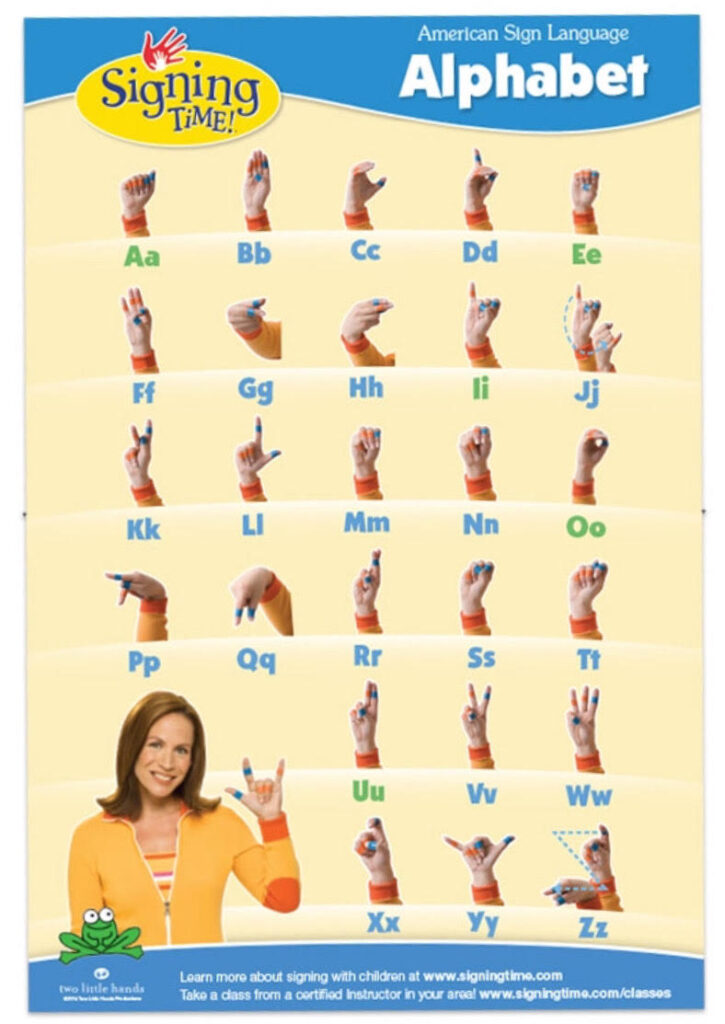You may be asking, “Why do my kids need to learn to sign the alphabet if they know plenty of other signs?” or “What is the point of learning to sign the alphabet?” That’s a fair question, and we have a few reasons to offer in response.
First, when signing, we still use the names of people and places. There is no possible way to create a sign for each of these names, nor would it be possible to know them all. So we spell them. This is called “fingerspelling”, and it is used a lot in signing.
Fingerspelling is also used when we don’t know the sign for something. If you are very familiar with the ASL alphabet, you can use any word you need to, whether you know the sign for it or not. You can spell it out.
Or what if the person you are signing to does not know the sign you are using? Fingerspelling helps on both sides of the conversation, both in expressing and in understanding.
Where to begin
We have to know the ASL alphabet signs in order to use them, so this is our starting point.
 We all have different learning styles, so tackle this however it works best for you and your kids. Perhaps choose one letter at a time and practice it over several days. Or it may work better to learn a section of the alphabet at a time, like A, B, C first, then D, E, F, and so on. Another option is to tackle the entire alphabet repeatedly, letting more of the signs stick with you each time until you know the entire thing. Do what works for you and your family.
We all have different learning styles, so tackle this however it works best for you and your kids. Perhaps choose one letter at a time and practice it over several days. Or it may work better to learn a section of the alphabet at a time, like A, B, C first, then D, E, F, and so on. Another option is to tackle the entire alphabet repeatedly, letting more of the signs stick with you each time until you know the entire thing. Do what works for you and your family.
Learn them the right way
Be sure that you are forming the letters so that they are facing the right way and not turning the sign to the side. And keep your hands relaxed. There is no need to squeeze the letters, but don’t be flopsy either. Sign clearly with a relaxed hand.
Also, with your hands, keep them steady, not bouncing or punching forward. Bouncing is just difficult to watch, and punching is over-emphasizing or shouting.
Practice, practice, practice!
Once you have the signs down correctly, practice them forward and backward, at different speeds, in whatever way you can in order to learn them fully. Mix them up instead of keeping them in alphabetical order. Get to the point where you know them so well that it doesn’t take any thought to produce the correct sign.
Signing Time tools to help you
We have several tools to help you and your kids learn and practice the ASL alphabet!
Our Signing Time Dictionary has diagrams and detailed instructions for forming each of the letters.
Of course, a MySigningTime digital subscription gives you access to the Signing Time Complete Collection, with the Season 1 ABC Signs and Practice Time ABCs videos. Season 2 also includes alphabet and fingerspelling practice. A fun way to learn upper and lower case letter recognition and letter sounds is the fun (but non-signing) Baby Joy Joy Alphabet.
We also have coloring pages to reinforce learning several of the letters of the alphabet here. Look over the download list for the letters you’d like to work on.
Additional benefits of knowing the ASL Alphabet
Knowing the signs and sounds for the alphabet not only helps children to express themselves more while signing, it also helps them to understand new words, both in signing and in speaking. It also helps them more easily master reading and writing in English.
This article is from a teacher who uses My Signing Time in her classroom. She teaches her class to sign the alphabet at the beginning of the year, and then uses it in multiple ways to reinforce her core curriculum.
If you and your kids do not know how to sign the ASL alphabet quickly and easily, take some time to work on it today!

